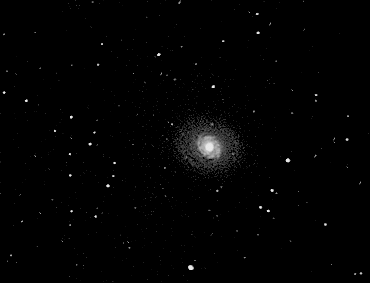

M94 was discovered by Pierre Méchain on 22nd March 1781, and Charles Messier put it in his catalogue two days later. It is a spiral galaxy, and a little unusual. It has a very bright core (overexposed in my image) surrounded by a tight ring of star-forming regions. Outside that is a much fainter region that shows weakly in my picture.
 |
M92 captured with my LX200 fitted with a 0.33 focal reducer and my MX716 monochrome camera. Date and Time: 19th April 2013 22:31 to 22:42 UT Camera: MX716 with IR-block filter Telescope: LX200 with 0.33 focal reducer Capture: Star_mx7. Exposures 7, 15, 30 sec. 5, 5, and 10 frames respectively, and dark frames at each exposure. Processing: Star_mx7. Each frame normalised with the black-level clamp, non-linear stretch factor 25, and black level again. Dark frames subtracted in a custom built program. Frames from each exposure were stacked in RegiStax6. The resulting three pictures, enhanced with Scheme 1, were stacked again in RegiStax6 and finally PhotoImpact was used to raise the gamma to 2.0 and the brighness reduced to -15. |
||
In the past (prior to May 2013) I have subtracted the dark frames in star_mx7 prior to enhancing them with the non-linear stretch. However I have come to realise that the program was not subtracting the dark frame correctly. In the worst case most of the light frame disappeared and left a bright streak across the top of the picture. In the best case the image appeared hardly effected with hot pixels unaffected. I tried reloading the program from the Starlight-Xpress web site, but to no effect. So I wrote my own program to subtract a dark frame and used that. Sadly I know of no way to load pictures into star_mx7, so I had to enhance the dark frame as well as the light frames to subtract them later. The non-linear stretch in star_mx7 is so good that I know of no better way to do it. So the procedure was as follows:
Home Back to DSOs